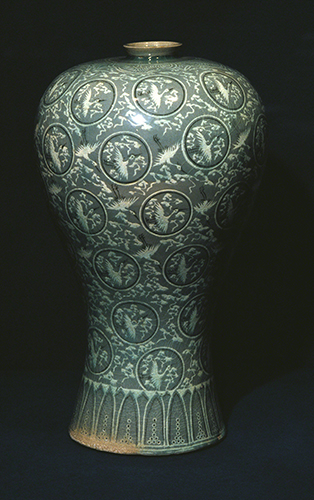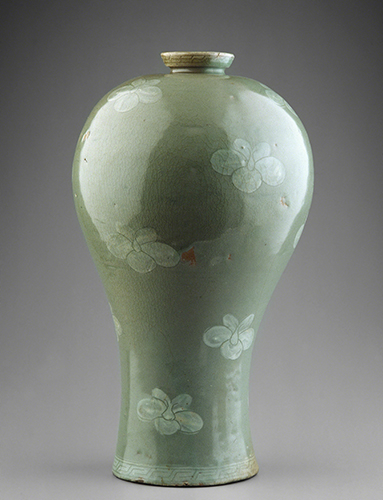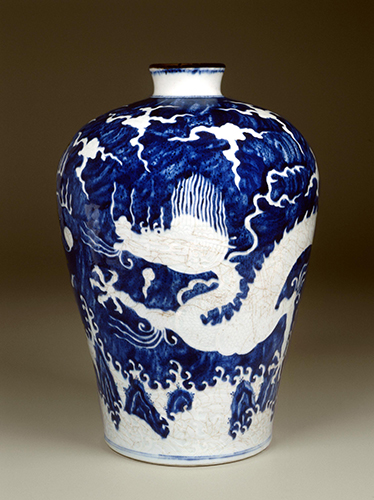Gem of the Month: The Maebyong Form
Nothing excites me more than beautiful ceramics. I’ve always had a fascination with all kinds of ceramic art. I always thought I would like to make ceramic art if I did not paint—probably because I love the different effects possible with glazes—but one cannot fit a kiln and potter’s wheel in the living room of a one-bedroom apartment! So, I look at images of ceramic art.
 |
| Korea, Maebyong bottle, ca. 1150. Porcelain with celadon glaze, about 15 ¾" (40 cm) high. Gan-Song Art Museum, Seoul, South Korea. Image © 2019 Davis Art Images. (8S-27964) |
| This work is considered the “68th National Treasure of Korea.” |
The mei-p’ing form from China reached perfection in the maebyong (or, maebyeong) shape in Korea. The name means "plum bottle," referring to its usual function of holding plum branches. The maebyong was originally lidded and used to store liquids such as water, wine, or oil.
The celadon glaze, a blue-green to grayish-green hue, was perfected during the Goryeo kingdom in Korea. Koreans perfected celadon glazes after learning technological and kiln modifications from the Chinese. Korean ceramic artists initially learned the celadon glaze from Song (960–1279) artists, particularly from the Yue kilns. They created undecorated wares that emphasized the importance of the glaze's color in the aesthetic appreciation of the genre. In the 1100s, the Koreans investigated different forms of decoration involving incising, raised decoration, and inlay. This bottle contains a common Goryeo motif of a crane flying against clouds in alternating roundels. In Korea, the crane is considered a symbol of longevity and good luck.
The earliest Korean ceramic vessels are thought to date from between 6000 and 5000 BCE. Stoneware and earthenware were the major forms until porcelain was perfected during the Goryeo kingdom. The porcelain of the Goryeo period is considered the peak of refinement of Korean porcelain and was exported in large numbers, almost exclusively to Japan.
The first recorded centralized communities appeared during the first century BCE when three distinct kingdoms formed: Gogoryeo (37 BCE–668 CE), Baekje (18 BCE–653 CE), and Old Silla (57 BCE–668 CE).
The Goryeo kingdom replaced the Unified Silla kingdom (founded 668 CE) in 918 CE. During the Goryeo period, laws were codified and modeled on Chinese laws and Buddhist and Confucian beliefs. During this period, ceramics (particularly porcelain) reached the peak of perfection. The Goryeo kingdom was plagued by constant Mongol invasions and Japanese piracy. It fell in 1392 to the Yi family who established the Joseon Dynasty (1392–1910).
 |
| Korea, Maebyong Vase, 1200s. Glazed stoneware with celadon glaze, height: 15 1/4" (38.8 cm). © 2019 Museum of Fine Arts, Boston. (MFAB-1287) |
This example of the shape is, appropriately enough, decorated with painted plum blossoms.
 |
| China, Mei-p’ing vase, 1700s. Jingdezhen porcelain, height: 14 9/16" (37 cm). © 2019 Museum of Fine Arts, Boston. (MFAB-613) |
The Qing Dynasty (1644–1912) was the second foreign dynasty to rule China since the Six Dynasties period in the 700s. The ruling Manchu family came from Manchuria and restored social and political order after the chaos of the late Ming period. The Qing rulers continued the blue and white wares that had been perfected (and are the most typical) by Ming artists, with many different twists such as this vase, where the background is blue with white forms, instead of vice versa.
This porcelain is named for the city it was produced near, Jingdezhen in Jianxi province. The region has been an important ceramic center since the Han Dynasty (206 BCE–220 CE). By the time of the Song Dynasty (960–1279/1280), there were five famous kilns there. During the Ming Dynasty (1368–1644), Jingdezhen became the center for porcelain production in China, with kilns established there for imperial production only. At that time, twenty kilns were recognized for the perfection of their porcelain wares.
After the civil wars of the end of the Ming period, Jingdezhen wares declined slightly in quality. Under the guidance of the Jiangxi emperor (1661–1722), the kilns were revived and Jingdezhen porcelain reached its peak of perfection after 1680. This continued through its “golden period” of the Yongzheng (1722–1735) and Qianlong (1735–1796) emperors. Many new glazes were introduced, including the “gem blue” glaze that replaced cobalt in blue and white wares, seen in this mei-p’ing.


Comments